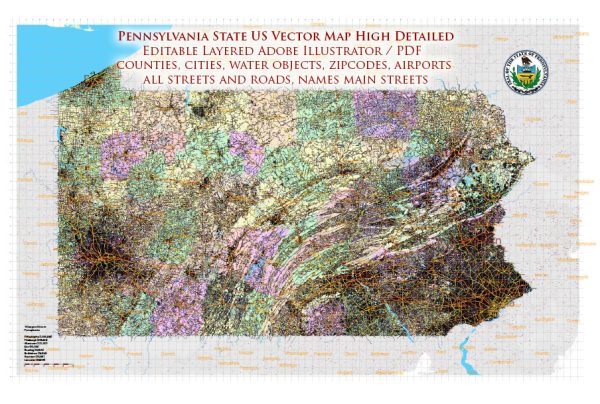Pennsylvania has a rich history of urban development that spans centuries, reflecting the economic, social, and cultural evolution of the state. The story of urbanization in Pennsylvania is closely tied to its industrialization, transportation networks, and demographic shifts.
- Colonial Era: The urban history of Pennsylvania can be traced back to the colonial era when Philadelphia was established in 1682 by William Penn. Philadelphia quickly grew into a bustling port city and became a significant center for trade and commerce in the American colonies.
- Industrial Revolution: The 19th century brought about significant changes with the onset of the Industrial Revolution. Cities like Pittsburgh and Scranton became industrial powerhouses, particularly in steel production and coal mining. Pittsburgh, known as the “Steel City,” was a major hub for steel manufacturing, while Scranton played a crucial role in the coal industry.
- Transportation Infrastructure: Pennsylvania’s urban development was closely tied to the expansion of transportation networks. The construction of canals and later the development of the railroad system facilitated the movement of goods and people, connecting urban centers and fostering economic growth.
- Immigration and Population Growth: The late 19th and early 20th centuries saw a significant influx of immigrants, contributing to the growth of urban populations. Cities like Philadelphia, Pittsburgh, and Allentown became melting pots of diverse cultures, with neighborhoods reflecting the ethnic backgrounds of their residents.
- Suburbanization and Post-World War II Era: Like many other states, Pennsylvania experienced suburbanization in the mid-20th century. The post-World War II period saw the rise of suburban communities as people moved away from urban centers. This trend was driven by factors such as the availability of affordable housing, improved transportation, and the desire for a more suburban lifestyle.
- Deindustrialization and Urban Renewal: The latter half of the 20th century brought challenges to Pennsylvania’s urban areas as the decline of traditional industries, particularly steel, led to economic struggles. Many cities faced issues of blight and population decline. Urban renewal projects were initiated to revitalize deteriorating neighborhoods, often involving the demolition of older structures and the construction of modern developments.
- Post-Industrial Transformation: In recent decades, Pennsylvania has undergone a transformation from an industrial to a more diversified economy. Cities like Philadelphia and Pittsburgh have shifted towards technology, healthcare, education, and other service-based industries. The revitalization of urban cores, adaptive reuse of historic buildings, and investments in infrastructure have played key roles in this transformation.
- Cultural and Educational Hubs: Pennsylvania’s cities have become cultural and educational hubs. Philadelphia is renowned for its historic sites, museums, and universities, while Pittsburgh has developed a reputation for innovation and technology.
Overall, Pennsylvania’s urban development is a dynamic narrative that reflects the changing economic landscape, demographic shifts, and the ongoing efforts to adapt to new challenges and opportunities.


 Author: Kirill Shrayber, Ph.D.
Author: Kirill Shrayber, Ph.D.